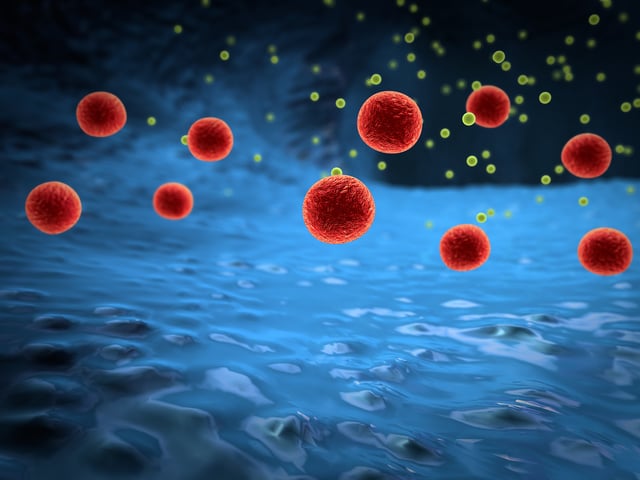
Smart materials with antifouling properties are relevant in many areas, for example in biomedical applications where it can be desirable to control the binding of cells. Curious to learn more about how such smart materials are developed and how QSense QCM-D is used in the material characterization, I reached out to Lucas Teunissen, Ph. D. - candidate in the group of professor Han Zuilhof, in the Laboratory of Organic Chemistry at Wageningen University & Research. Lucas’s research focus is on innovative polymer coatings, and in a recent study1 they developed a new thermoresponsive polymer brush that shows strong antifouling performance, and which could be of interest as a smart coating in biomedical applications.
In this post, I share what I learned from the interview with Lucas.
My research mainly focuses on the development of innovative polymer coatings that can introduce specific properties to a target substrate, Lucas says. In contrast to typical polymer coatings, however, the type we employ are covalently bound polymers with high grafting density, so called polymer brushes, he explains.
Polymer brushes have been, and are, currently investigated intensively, Lucas says. The reason is that using controlled polymerization techniques, surface properties can be tailored with nanoscale precision. Although these controlled polymerization techniques are compatible with a vast range of (potential) monomers, most polymer brushes in scientific research are synthesized using a small number of well-established and thoroughly characterized monomers. In our research, and particularly in this study, we set out to contribute to the polymer brush research field by synthesis and characterization of polymer brushes synthesized from novel building blocks, Lucas says.
One of the more recent developments regarding polymer brush coatings is the use of stimuli-responsive polymers to create so-called ‘smart’ applications, he continues. One of the most commonly employed responsive polymers is poly(N-isopropylacrylamide) (poly(NIPAM)), which reacts to changes in temperature. Despite many advantages, employing poly(NIPAM) limits the possibilities in terms of more complex polymer brush architectures, such as copolymer structures. Control over polymerization of NIPAM is not straightforward and synthesis of more complicated polymer brush architectures is therefore limited. It is therefore of significant interest to study new monomers that also bring about thermoresponsive properties, but do not exhibit the same limitations in terms of polymerization. As the number of alternative thermoresponsive polymers used in polymer brush research is limited, we aimed to synthesize and characterize a new thermoresponsive polymer brush, poly(N-2-(methacryloyloxyethyl)pyrrolidone) (poly(NMEP)), and investigate its potential for production of stimuli-responsive surfaces, Lucas says.
In a preliminary literature study, we came across a study that reported thermoresponsive properties of poly(NMEP) in solution, he continues. We decided to attempt to grow this polymer from a surface, using surface-initiated atom transfer radical polymerization (SI-ATRP), and study its thermoresponsive properties, Lucas explains. After successfully doing so, we wanted to show that it was indeed possible to create more complex polymer brush architectures using poly(NMEP) by synthesizing a block copolymer using poly(NMEP) as the base. Finally, the antifouling properties of the polymer brush against protein solutions were assessed to investigate its potential in biomedical applications.
The antifouling properties of the poly(NMEP) brushes were assessed using QCM-D where we exposed poly(NMEP)-modified QCM-D sensors to a flow of protein solutions and simultaneously, measured the amount of protein that adsorbed on the surface, Lucas says.
In brief, the experiments were executed as follows:
The QCM-D experiments showed that a poly(NMEP) coated surface greatly reduces the amount of protein that adsorbs on a surface, Lucas says. These results helped us judge the potential of the poly(NMEP) brushes as a component in biomedical devices.
This study was carried out to investigate a new thermoresponsive polymer brush based on NMEP, Lucas says. Our aim was to not only synthesize, but also to thoroughly characterize different aspects of the poly(NMEP) brushes in order to assess its potential as a component in biomedical devices.
We showed that Poly(NMEP) brushes exhibit thermoresponsive properties and we also demonstrated that it can be easily incorporated in more complex polymer brush architectures. The QCM-D experiments gave insight in the potential applicability for biomedical devices which now can be used by other researchers in the field when designing their polymer brush coatings.
To conclude, poly(NMEP) is a viable option when thermoresponsive properties in a polymer brush are desired, Lucas says. Apart from the thermoresponsive character, poly(NMEP) can be easily incorporated in more complex brush architectures. These properties, in combination with the strong antifouling performance, make poly(NMEP) brushes of great interest as a smart coating in biomedical devices, he concludes.
Compared to QCM, QCM-D measures an additional parameter, and provides more information about the system under study.
Discover how QCM-D analysis reveals real-time etching dynamics, helping optimize cleaning processes and protect surfaces from unwanted damage.
Discover how QSense QCM-D helps tackle fouling challenges across industries
Discover how QCM-D enables real-time, label-free analysis of supported lipid membrane formation, structure, and dynamics for advanced research
Learn how QSense QCM-D analysis can reveal membrane fouling dynamics and optimize cleaning strategies for more efficient water treatment
Learn how QSense QCM-D helps detect and prevent surface-induced instabilities in biologics. Join our webinar for insights and practical examples.
Learn about the top QSense sensors for analyzing biopharmaceutical drug-surface interactions in the context of IV bags.
Learn about QCM-D, Quartz Crystal Microbalance with Dissipation monitoring - an analytical tool for surface interaction studies at the nanoscale.
Explore QSense QCM-D sensors to optimize cleaning efficiency with real-time insights, enhancing formulations and protocols across various conditions.
